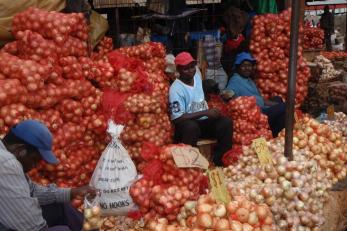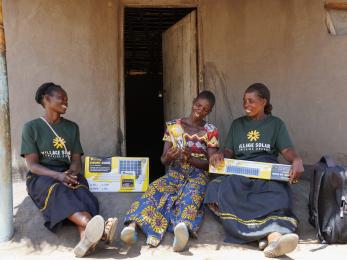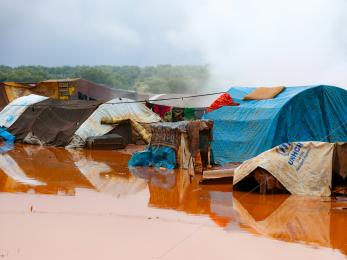The Potential of Mobile Phones in Transforming Agriculture for Smallholder Farmers

Mobile phone technologies are presenting smallholder farmers with unprecedented opportunities to run their operations more productively and to grow their income levels. However, farmers continue to face a plethora of challenges such as lack of financial support, marketing challenges and lack of information. These are some of the key findings from the Agri-Fin Mobile Program baseline and product development surveys that were carried in Indonesia, Uganda and Zimbabwe in the last half of 2012.
Results from the surveys show that the cost of information, from planting decision to selling at the market can make up a significant contribution to total production costs. For example, the surveys in all the three countries noted that information asymmetry is an important contributor to overall transaction costs for the majority of smallholder farmers – with a great potential of increasing farmer’s income if made available at affordable prices.
The baseline surveys, conducted between August and November 2012 by Mercy Corps and various development consultants analyzed the potential of ‘bundling’ information services and financial products that can be delivered via mobile phones to assist smallholder farmers in the three countries. A sample of respondents was derived from specific districts focusing on a number of specifically selected value chain crops. In Zimbabwe, the survey focused on maize, tomatoes and onion, in Uganda maize, beans and bananas (plantain or matooke) were selected, while in Indonesia the program focused on rice, maize, chili peppers and potatoes. Complimentary information was derived from focus group discussions and interviews with input suppliers and merchants in all the three countries.
There appears to be a great deal of potential for reaching smallholder farmers in all the three countries because the majority of surveyed households – have access to at least one mobile phone and own at least one active SIM card. For example in Zimbabwe, more than 80 percent of smallholder farmers have a mobile phone and more than 94 percent of the households have access to a mobile phone. In Uganda, 65 percent of the farmers have a mobile phone with 90 percent of the households having access to a mobile phone. The figures in Indonesia indicated that 83 percent of smallholder farmers have a mobile phone and all the households have access to a mobile phone. The majority of farmers interviewed in all the three countries said they are comfortable using their phones to receive money, with levels of transactions varying from one country to the other.
Usage of mobile money services by smallholder farmers was relatively high in Uganda and Zimbabwe with 46 percent and 64 percent respectively. Based on the responses from more than 60 percent of smallholder farmers in Zimbabwe and Uganda mobile technologies and mobile money services are predominantly used by males – those with a secondary education or higher, and those in their prime working age (35-54). Females, senior citizens (55+), and those with no formal education or only primary education, have the least access to mobile money services.
Notably, the surveys also highlighted that access to agricultural information has been widespread but support is needed for disseminating information on market prices, product processing and weather information. At present most farmers depend on the word of mouth to get information from extension officers who are thinly spread on the ground. In Indonesia for example, about 200 Agritex officers are currently serving more than 400 000 farmers in Karawang District. Interestingly, in Zimbabwe a few farmers reported having received agriculture and market information through SMS (5 percent) with Uganda and Indonesia having less than 3 percent of farmers receiving information through SMS. Farmers in the three countries also rely on merchants, friends, relatives, and neighbors as sources of information on market prices.
Marketing has presented major challenges for many smallholder farmers with almost all the farmers interviewed in the three countries noting poor market infrastructure, unfair trading systems by middlemen and poor prices as their major drawback to better income.
Another challenge noted by farmers in all the three countries is lack of access to basic financial services such as bank accounts or insurance. As highlighted in the case of Uganda, farmers travel an average 45 kilometers to visit a bank, get funds or make a transfer. Having a low and unpredictable income makes it difficult to build up savings, buy insurance or secure loans. Among the farmers sampled in both Uganda and Indonesia, less than 10 percent have access to insurance and more than 70 percent in all the three countries are un-banked. Village Savings and Loans Initiatives/Associations are attracting a significant number of farmers particularly women.
The research identified a number of key opportunities for the Agri-Fin Mobile program – chief among them being a facilitator of farmers’ access to inputs with merchants, provide information on input prices through a Mobile Network Operator platform, promote market transparency and linking farmers to various financial services.
The next steps for the Agri-Fin Mobile program is to develop and promote business models with partners that will be used to develop various products for farmers and other stakeholders in the financial, agriculture and mobile industry.
These are highlights of the research findings. Abridged versions of the reports from each country can be found at the program website on http://bit.ly/agri-finmobile
The Agri-Fin Mobile program is an innovative program to support social enterprises to provide low-income farmers in the developing world with ‘bundled’ support integrating financial services, market information and agricultural services to boost their harvests. The program aims to increase the income of 180,000 low-income farmers in Indonesia, Uganda and Zimbabwe by 30 percent within the first three years. The program is supported by the Swiss Agency for Development and Cooperation.

